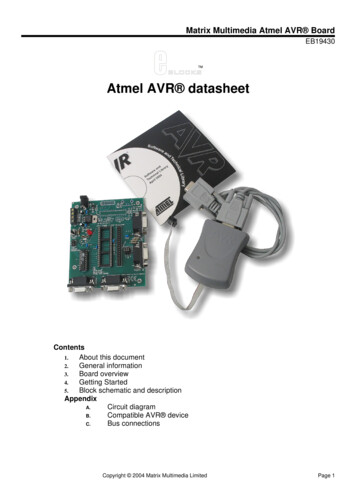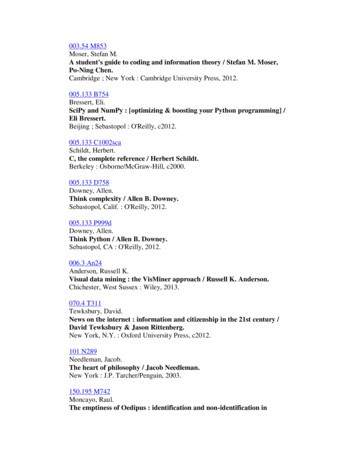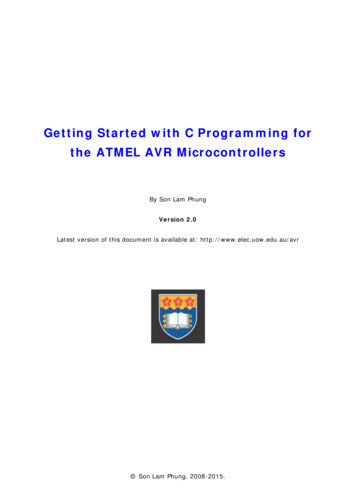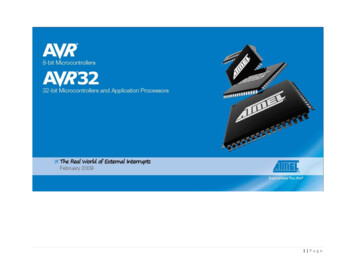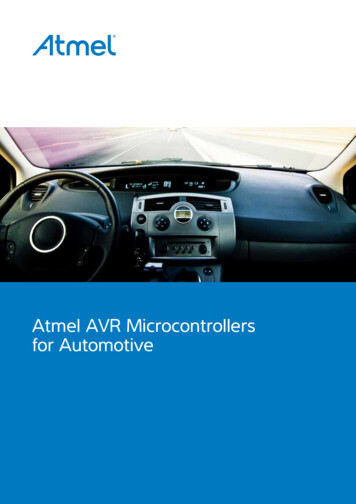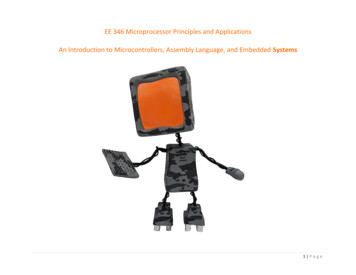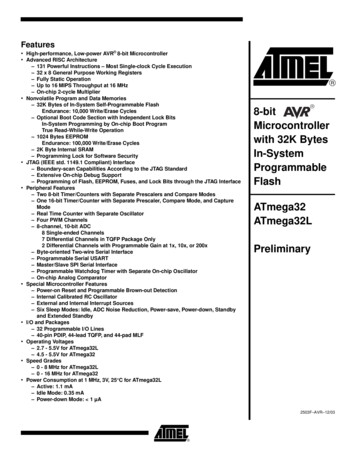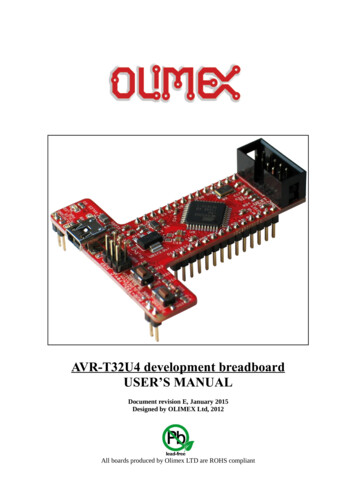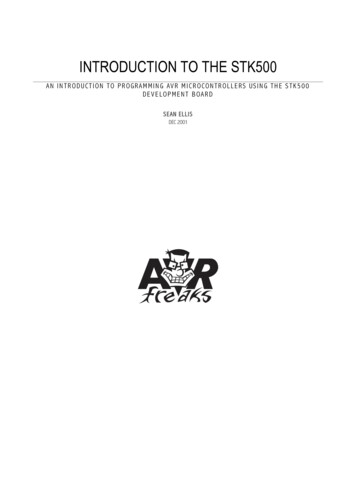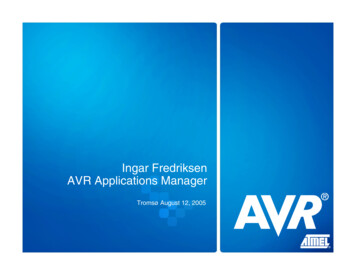
Transcription
Ingar FredriksenAVR Applications ManagerTromsø August 12, 2005 Atmel Norway 2005
The history of computers Atmel Norway 2005
Foundation for modern computing An automatic computing machine must have: A store for the numbers (memory) A device for performing arithmetic operations (ALU) A device for causing the operations of the machine (CU) An input and output device (Mouse, keyboard, screen)www.atmel.comTromsø August 12, 20053
First Generation: The Manchester Computer The world’s first storedprogram electronic digitalcomputer Executed its first program onJune 21st in 1948. Designed and constructed byMachester University Ferranti Ltd. was given rightsto produce and sell acommercial version of themachine (Manchester markI)www.atmel.comTromsø August 12, 20054
The Most Important Step: Integrated Circuits The introduction ofintegrated circuits led to thethird generation ofcomputers Mini-machines made out oflogic gates Small scale integratedcircuitswww.atmel.comTromsø August 12, 20055
tiny13 AVR chipwww.atmel.comTromsø August 12, 20056
tiny13 AVR chipwww.atmel.comTromsø August 12, 20057
The AVR fairy talehow the west was won and how we got there Atmel Norway 2005
www.atmel.comTromsø August 12, 20059
AVR Standard Product Revenues1601401201008060402001997 1998 1999 2000 2001 2002 2003 2004www.atmel.comTromsø August 12, 200510
Atmel Norway AS - today 120 employees in Trondheim 50 employees abroad 35 products in production 12.000.000 chips/month 4.5 chips pr. second Own 100% by Atmel Corp Nasdaq: ATMLwww.atmel.comTromsø August 12, 200511
Key AVR Features – the sales pitch Flash and EEPROM, both in-system programmable Highest performance, low power 8-bit MCU Excellent code density in C and assembly A broad family of MCUs - 1K to 256K Bytes flash High integrationwww.atmel.comTromsø August 12, 200512
256K[Flash in32-pin44-pinTromsø August 12, 200548-pin64-pin100-pin13
8-Pin Family Details Tiny25/45/85 Three Pin and fuctionally compatibledevicesDeviceFlashRAMEEpromDifferential channels with 10/20X GainTiny131K6464 High frequency (200 KHz) 8-bit PWMTiny252K128128 Pin-change interrupt on all I/O-pinsTiny454K256256 Low power consumptionTiny858K512512 4-channel 10-bit ADC 100 nA power down modedebugWIRE On-chip DebugTiny13 Pin compatible with Tiny25/45/85 4-channel 10-bit A/D Pin-change interrupt on all I/O pins Low power consumption 100 nA power down mode debugWIRE On-chip DebugBackwww.atmel.comTromsø August 12, 200514
14-pin family highlights Pin/Functionally compatibledevices 8-channel 10-bit ADC 7 Differential channels with1/8/20X Gain Pin-change interrupt on 44K256256Tiny848K512512 Low power consumption 100 nA power down mode 1.8 to 5.5 volt operation Internal 8 MHz RC oscillator debugWIRE On-chip DebugBackwww.atmel.comTromsø August 12, 200515
20-pin family Tiny26/46/86 11-channel 10-bit A/D Differential Channels with 10/20Xgain High frequency (200 KHz) PWM Debugwire On-Chip Debug(Tiny45/85) FlashRAMEEVCCTiny262K1281282.7 – 5.5VTiny464K2562561.8 – 5.5VTiny868K5125121.8 – 5.5VTiny23132K1281281.8 – 5.5V8 MHz Internal RC Tiny2313 Hardware USART Interrupt on pin-change on all I/O USI gives hardware support forSPI/TWI Low power consumption Device100 nA Power down modeDebugWIRE On-Chip DebugBackwww.atmel.comTromsø August 12, 200516
The Development of an AVRMicrocontroller Atmel Norway 2005
Developing a MicrocontrollerSpecificationDigital designand VerificationAnalog designand nalVerificationwww.atmel.comTromsø August 12, 200518
Digital Design CPU, Interrupt Controller,DMA, Peripheral Functionsetc. Verilog Example:always @ ( posedge clk )begin // Register write Developed in HDL (Verilog)if((adr UCSRB adr)&iowe)begin Verification on HDL modelrxcie DD dbus[7]; Module Reuse andImprovementtxcie DD dbus[6];udrie DD dbus[5];rxen DD dbus[4]; IP Modulestxen DD dbus[3]; HDL synthesischr9 DD dbus[2];endendwww.atmel.comTromsø August 12, 200519
Analog Design Memories, ADCs, DACs,Regulators, Oscillators,PADs, etc. Analog modulesimplemented as schematicdrawings Digital Interfaces IP Modules Process shrink (libraries)0.35µ, 0.25µ, 0.18µ, 0.13µwww.atmel.comTromsø August 12, 200520
Lay Out The Digital Design has beensynthesized to a low levelrepresentation The Digital Design has to bemerged with the AnalogDesign The Lay Out must meetperformance and sizeconstraintswww.atmel.comTromsø August 12, 200521
Silicon Diewww.atmel.comTromsø August 12, 200522
Packaging Die All devices available in Die Form Micro Lead Frame Packaging Low cost package technology Very good noise immunity substrateconnected to ground Smallest standard package available Near chip-scale package size; Save up to69% of board spaceTQFP9x12 x16 xsize MLF size TQFP area95x581127x7144169x9256Size in millimeterswww.atmel.comMLF254981area31 %34 %32 %Area in mm2Tromsø August 12, 200523
The future Atmel Norway 2005
Trends into the future Shrink Size decrease will continue Lower production cost and end user price Lower power Today 1.8V operation 1 Li cell or 2 AA/AAA batteries to run0.9V technology will be introduced 1 AA/AAA battery to run On-chip debug The end of expensive in-circuit emulators Open source Linux OS User interaction. www.avrfreaks.netwww.atmel.comTromsø August 12, 200525
Atmel Norway AS - today 120 employees in Trondheim 50 employees abroad 35 products in production 12.000.000 chips/month 4.5 chips pr. second Own 100% by Atmel Corp Nasdaq: ATML. www.atmel.com Tromsø August 12, 2005 12 Key AVR Features - the sales pitch
